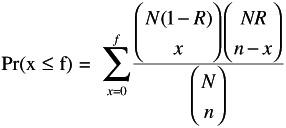RELIABILITY DEMONSTRATION TEST METHODS
Attributes tests can be used when:
-
The accept/reject criterion is a go/no-go situation.
-
The probability distribution of times to failure is unknown.
-
Variables tests are found to be too expensive.
SMALL POPULATIONS ” FIXED-SAMPLE TEST USING THE HYPERGEOMETRIC DISTRIBUTION
When items from a small population are tested and the accept/reject decision is based on attributes, the hypergeometric distribution is applicable for test planning. The definition of successfully passing the test will be that an item survives the test. The parameter to be evaluated is the population reliability. The estimation of the parameter is based on a fixed sample size and testing without repair. The method to use is described below:
-
Define the criteria for success/failure.
-
Define the acceptance reliability, RS.
-
Specify the confidence level or the corresponding consumer's risk, ² .
-
Specify, if desired, producer's risk, a. (Producer's risk can be used to calculate the design reliability target, Rd, needed in order to meet the a requirements.)
The process consists of a trial-and-error solution of the hypergeometric equation until the conditions for the probability of acceptance are met.
The equation that is used is:

where Pr(x < -f) = probability of acceptance; f = maximum number of failures to be allowed; x = observed failures in sample; R = reliability of population; N = population size; and n = sample size.

LARGE POPULATION ” FIXED-SAMPLE TEST USING THE BINOMIAL DISTRIBUTION
When parts from a large population are tested and the accept/reject decision is based on attributes, the binomial distribution can be used. Note that for a large N (one in which the sample size will be less than 10% of the population), the binomial distribution is a good approximation for the hypergeometric distribution. The binomial attribute demonstration test is probably the most versatile for use on product components for several reasons:
-
The population is large.
-
The time-to-failure distribution for the parts is probably unknown.
-
Pass/fail criteria are usually appropriate.
As with the hypergeometric distribution, the procedure begins by identification of:
-
Specified reliability, R s
-
Confidence level or consumer's risk, ²
-
Producer's risk, ± (if desired)
The process consists of a trial-and-error solution of the binomial equation until the conditions for the probability of acceptance are met. The equation that is used is:

where Pr(x < f) = probability of acceptance; f = maximum number of failures to be allowed; x = observed failures in sample; R = reliability of population; and n = sample size.
LARGE POPULATION ” FIXED-SAMPLE TEST USING THE POISSON DISTRIBUTION
The Poisson distribution can be used as an approximation of both the hypergeometric and the binomial distributions if:
-
The population, N, is large compared to the sample size, n.
-
The fractional defective in the population is small (R population > 0-9).
-
The process consists of a trial-and-error solution using the following equation or Poisson tables, R s , R d , and various sample sizes until the conditions of a and ² are satisfied.

where Pr(x ‰ f) = probability of acceptance; f = maximum number of failures to be allowed; x = observed failures in sample; » poi = (n) (1 - R) (The reader should note that the » poi is the Poisson density and does not relate to failure rate); r = reliability of population; and n = sample size.
EAN: 2147483647
Pages: 235